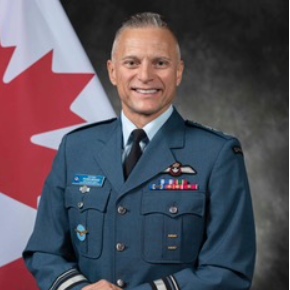Day Three | 6 November
8:00 - 8:55
REGISTRATION AND REFRESHMENTS
8:55 - 9:00
CHAIRMEN’S OPENING REMARKS
General (Ret'd) Frank Gorenc -
Former Commander,
USAFE-AFAFRICA
ENABLERS FOR FUTURE AIR OPERATIONS: ELECTRONIC ATTACK, AIR TO AIR REFUELLING, AEW & BATTLE MANAGEMENT
9:00 - 9:30
KEYNOTE PRESENTATION: ITALIAN AIR FORCE STRATEGY FOR FUTURE OPERATIONS
Lieutenant General Antonio Conserva -
Chief of Staff,
Italian Air Force
9:30 - 10:00
RAF COMBAT AIR – SETTING THE FORCE TO FLY, FIGHT AND WIN, IN THE 5TH GENERATION AND BEYOND
Air Commodore Chris Layden -
Combat Air Force Commander,
Royal Air Force
• The combat air platforms and capabilities we intend to field, and how we’ll employ them
• How we will need to support our national combat air capability, founded on a conflict-ready national arsenal and the full spectrum of enablement, ranging from logistics to information and cyber/electro-magnetic capabilities
• What sort of fighter pilots we will need, and how we will train them: their mindset, capabilities and approach
10:00 - 10:30
ENABLING COMBAT AIR AGILITY: INTEROPERABILITY ON THE GROUND
Air Vice-Marshal Shaun Harris CBE -
Director Support and Chief Engineer,
Royal Air Force
• Configured for efficiency, not resilience and agility?: Since the end of the Cold War, we have become configured more for efficiency in smaller scale conflict than the resilience and agility required in full-scale coalition warfighting.
10:30 - 11:00
MORNING COFFEE AND NETWORKING BREAK
INCREASING TRAINING CAPACITY
11:00 - 11:30
PLANS AND PRIORITIES FOR AIR FORCE TRAINING, AND IMPACT OF 6TH GENERATION FIGHTER DEVELOPMENT
Major General Gregory Kreuder -
Commander 19th Air Force, Air Education and Training Command (AETC),
19AF/AETC
• Priorities for producing next-generation aviators for America and its allies
• How NGAD is influencing training plans for the US Air Force
• Influence of technology on sustaining the combat capability of the US Air Force

Major General Gregory Kreuder
Commander 19th Air Force, Air Education and Training Command (AETC)19AF/AETC

11:30 - 12:00
MULTINATIONAL FAST JET AND ADVERSARY TRAINING REQUIREMENTS – NATO FLIGHT TRAINING EUROPE
Jason Hawker -
Principal Officer, NATO Flight Training Europe,
NSPA
• Successes and challenges of the NFTE after reaching full operational capability
• Leveraging existing structures to maximise training capacity
• Collaboration with industry partners to deliver on NFTE goals
12:00 - 12:30
DEVELOPMENTS IN THE SURROGATE TRAINING FAMILY OF SYSTEMS TO SUPPORT FUTURE FIGHTER PILOTS
Col. (Ret.) David Jake Timm -
Future Fighter Training Reforge SME,
U.S. Air Force
• Supporting the next generation of pilots with training designed around the integration of CCAs and autonomy
• US Air Force Leadership priorities to determine the pace of advancing future fighter training and readiness
• How developments in 6th generation fighter programmes are influencing training programmes
11:50 - 12:20
MULTI-NATIONAL SUPPORT TO NATO READINESS
Daniele Cucchi -
Aviation Support Programme Manager,
NSPA
Jason Hawker - Principal Officer, NATO Flight Training Europe, NSPA
- Aviation support to Allies through the NSPA
- The growth of the NATO Flight Training Europe High Visibility Project
- Collaborating with Industry to enable innovative and data driven solutions
12:30 - 13:00
PANEL DISCUSSION: ADVANCING OPERATIONAL TRAINING FOR CURRENT AND FUTURE CONFLICTS: ESSENTIAL MISSIONS AND GETTING READY FOR CCAs
Major General (Ret'd) Sylvain Ménard -
Former Chief Fighter and NORAD Capability,
Royal Canadian Air Force
Major General Jeff Smyth - Chief Air & Space Force Development, Royal Canadian Air Force
Col. (Ret.) David Jake Timm - Future Fighter Training Reforge SME, U.S. Air Force
• What are the key missions that pilots must ace in a peer conflict and given lessons from Ukraine? How must air forces prioritise live and synthetic training for lethal advantage?
• What are the future trends in training for 6th generation aircraft, alongside unmanned systems?
• Changing training needs on the fly: How to build-in flexibility and minimize disruption in the transition from a traditional training cycle? How would existing trainingregimes need to evolve and how quickly can this transition take place when needed?
• What might the teaching of “softer” but necessary skills such physical and mental resilience need to look like and how to measure and assess these skills?
• How are air forces increasing retention of new pilots, and what strategies are they using to recruit the next generation of fighter pilots?

Major General (Ret'd) Sylvain Ménard
Former Chief Fighter and NORAD CapabilityRoyal Canadian Air Force

13:00 - 14:00
NETWORKING LUNCH BREAK
MODERNISATION STRATEGIES TO RESPOND TO CURRENT THREATS
14:00 - 14:30
MODERNISATION OF THE BELGIAN AIR FORCE TO ENSURE OPERATIONAL READINESS
• Updates on the ongoing transition from F-16 to F-35A
• Priorities for ensuring pilots and maintainers are fully equipped to operate and sustain 5th generation aircraft
• Considerations of international collaboration and interoperability
14:30 - 15:00
STRENGTHENING EXISTING FIGHTER CAPABILITIES WITH TARGETED UPGRADES AND FLEET EXPANSION
Brigadier General Csaba Ugrik -
Flight Director,
Hungarian Defence Forces
• Ensuring readiness and interoperability within NATO
• Maintaining a cost-effective defence strategy with strategic fleet expansion
• How targeted upgrades are ensuing the Hungarian Defence Force stays ahead of evolving threats
15:00 - 15:30
HOW THE RMAF IS MODERNIZING ITS FLEET TO INCREASE COMBAT STRENGTH
Major General Ahmad Khusairi bin Ahmad Fadil -
Air Support Commander,
Royal Malaysian Air Force
• Enhancing combat air capabilities, and addressing gaps with additional F/A-18s
• Technical and logistical challenges of integrating new aircraft with the existing fleet, and steps to ensure operational compatibility
• Collaboration with allies and partners to enhance maintenance efficiency and operational readiness

Major General Ahmad Khusairi bin Ahmad Fadil
Air Support CommanderRoyal Malaysian Air Force

15:30 - 16:00
AFTERNOON TEA AND NETWORKING BREAK
HARNESSING AIR POWER FOR MULTI-DOMAIN OPERATIONS
16:00 - 16:30
ENSURING AIR SUPERIORITY OF NAVAL AVIATION THROUGH ADVANCED TTP ACROSS COMBAT MISSION AREAS
• Refining the latest innovations and tactical strategies in Naval air operations
• Enforcing combat proficiency standards for air combat training and tactics
• Ensuring alignment of training procedures and programs to mitigate gaps across all platforms
16:30 - 17:00
CLOSING KEYNOTE PRESENTATION: ITALIAN NAVAL AVIATION
Rear Admiral Giancarlo Ciappina -
Commander, Naval Aviation Department,
Italian Navy
• Prioritising stealth and multirole strike capabilities with the F-35 fleet
• Enhancing carrier air wing operations and integrating with NATO maritime forces
• Future priorities to integrate manned-unmanned teaming, and counter A2/AD threats























